Before Becoming a World Heritage: Spatiotemporal Dynamics and Spatial Dependency of the Soundscapes in Kulangsu Scenic Area, China
Abstract
:1. Introduction
2. Materials and Methods
2.1. Study Area
2.2. Data Collection
2.2.1. Soundscape and Landscape Perception
2.2.2. Analysis of Landscape Characteristics
2.3. Mapping Process
2.4. Statistical Analysis
3. Results
3.1. Spatiotemporal Dynamics of Soundscape and Landscape Perceptions
3.1.1. Soundscape Mapping
3.1.2. Landscape Satisfaction Degree
3.2. Spatial Landscape Characteristics
3.3. Spatial Regression Models of Soundscape Quality
3.3.1. Multicollinearity Diagnostic Results
3.3.2. Global Spatial Regression Model
3.3.3. Local Spatial Regression Model
4. Discussion
4.1. Spatiotemporal Dynamics of Soundscape and Landscape in Kulangsu
4.2. Spatial Dependencies of Soundscape Quality
4.3. Limitations and Future Studies
5. Conclusions
Supplementary Materials
Author Contributions
Funding
Data Availability Statement
Acknowledgments
Conflicts of Interest
References
- Zlotnik, H. World urbanization: Trends and prospects. In New Forms of Urbanization; Routledge: London, UK, 2017; pp. 43–64. ISBN 1315248077. [Google Scholar]
- Margaritis, E.; Kang, J. Relationship between urban green spaces and other features of urban morphology with traffic noise distribution. Urban For. Urban Green. 2016, 15, 174–185. [Google Scholar] [CrossRef]
- Zhang, Y.; Han, M.; Chen, W. The strategy of digital scenic area planning from the perspective of intangible cultural heritage protection. EURASIP J. Image Video Process. 2018, 2018, 130. [Google Scholar] [CrossRef]
- Liu, H.-L.; Shen, Y.-S. The impact of green space changes on air pollution and microclimates: A case study of the Taipei metropolitan area. Sustainability 2014, 6, 8827–8855. [Google Scholar] [CrossRef]
- Gao, T.; Liu, F.; Wang, Y.; Mu, S.; Qiu, L. Reduction of atmospheric suspended particulate matter concentration and influencing factors of green space in urban forest park. Forests 2020, 11, 950. [Google Scholar] [CrossRef]
- Wen, C.; Albert, C.; von Haaren, C. The elderly in green spaces: Exploring requirements and preferences concerning nature-based recreation. Sustain. Cities Soc. 2018, 38, 582–593. [Google Scholar] [CrossRef]
- Liu, J.; Kang, J.; Behm, H.; Luo, T. Landscape spatial pattern indices and soundscape perception in a multi-functional urban area, Germany. J. Environ. Eng. Landsc. Manag. 2014, 22, 208–218. [Google Scholar] [CrossRef]
- WHO. Urban Green Spaces: A Brief for Action; World Health Organization: Geneva, Switzerland, 2017. [Google Scholar]
- Vienneau, D.; de Hoogh, K.; Faeh, D.; Kaufmann, M.; Wunderli, J.M.; Röösli, M.; SNC Study Group. More than clean air and tranquillity: Residential green is independently associated with decreasing mortality. Environ. Int. 2017, 108, 176–184. [Google Scholar] [CrossRef]
- Herrera-Montes, M.I. Protected area zoning as a strategy to preserve natural soundscapes, reduce anthropogenic noise intrusion, and conserve biodiversity. Trop. Conserv. Sci. 2018, 11, 1940082918804344. [Google Scholar] [CrossRef]
- Miller, N.P. US National Parks and management of park soundscapes: A review. Appl. Acoust. 2008, 69, 77–92. [Google Scholar] [CrossRef]
- Liu, J.; Xiong, Y.; Wang, Y.; Luo, T. Soundscape effects on visiting experience in city park: A case study in Fuzhou, China. Urban For. Urban Green. 2018, 31, 38–47. [Google Scholar] [CrossRef]
- Li, H.; Lau, S.-K. A review of audio-visual interaction on soundscape assessment in urban built environments. Appl. Acoust. 2020, 166, 107372. [Google Scholar] [CrossRef]
- Aletta, F.; Kang, J.; Axelsson, Ö. Soundscape descriptors and a conceptual framework for developing predictive soundscape models. Landsc. Urban Plan. 2016, 149, 65–74. [Google Scholar] [CrossRef]
- Hong, J.Y.; Ong, Z.-T.; Lam, B.; Ooi, K.; Gan, W.-S.; Kang, J.; Feng, J.; Tan, S.-T. Effects of adding natural sounds to urban noises on the perceived loudness of noise and soundscape quality. Sci. Total Environ. 2020, 711, 134571. [Google Scholar] [CrossRef]
- ISO 12913-1:2014; Acoustics-Soundscape-Part 1: Definition and Conceptual Framework. ISO Genebra: Vernier, Switzerland, 2014.
- Liu, J.; Yang, L.; Xiong, Y.; Yang, Y. Effects of soundscape perception on visiting experience in a renovated historical block. Build. Environ. 2019, 165, 106375. [Google Scholar] [CrossRef]
- Chen, Z.; Hermes, J.; Liu, J.; von Haaren, C. How to integrate the soundscape resource into landscape planning? A perspective from ecosystem services. Ecol. Indic. 2022, 141, 109156. [Google Scholar] [CrossRef]
- Hong, J.Y.; Lam, B.; Ong, Z.-T.; Ooi, K.; Gan, W.-S.; Kang, J.; Yeong, S.; Lee, I.; Tan, S.-T. Effects of contexts in urban residential areas on the pleasantness and appropriateness of natural sounds. Sustain. Cities Soc. 2020, 63, 102475. [Google Scholar] [CrossRef]
- Hong, J.Y.; Jeon, J.Y. Relationship between spatiotemporal variability of soundscape and urban morphology in a multifunctional urban area: A case study in Seoul, Korea. Build. Environ. 2017, 126, 382–395. [Google Scholar] [CrossRef]
- Liu, J.; Kang, J.; Luo, T.; Behm, H.; Coppack, T. Spatiotemporal variability of soundscapes in a multiple functional urban area. Landsc. Urban Plan. 2013, 115, 1–9. [Google Scholar] [CrossRef]
- Hong, X.-C.; Wang, G.-Y.; Liu, J.; Song, L.; Wu, E.T.Y. Modeling the impact of soundscape drivers on perceived birdsongs in urban forests. J. Clean. Prod. 2021, 292, 125315. [Google Scholar] [CrossRef]
- Watts, G.; Marafa, L. Validation of the tranquillity rating prediction tool (TRAPT): Comparative studies in UK and Hong Kong. Noise Mapp. 2017, 4, 67–74. [Google Scholar] [CrossRef]
- Hong, X.-C.; Wang, G.-Y.; Liu, J.; Dang, E. Perceived Loudness Sensitivity Influenced by Brightness in Urban Forests: A Comparison When Eyes Were Opened and Closed. Forests 2020, 11, 1242. [Google Scholar] [CrossRef]
- Hong, J.Y.; Jeon, J.Y. Influence of urban contexts on soundscape perceptions: A structural equation modeling approach. Landsc. Urban Plan. 2015, 141, 78–87. [Google Scholar] [CrossRef]
- Kogan, P.; Gale, T.; Arenas, J.P.; Arias, C. Development and application of practical criteria for the recognition of potential Health Restoration Soundscapes (HeReS) in urban greenspaces. Sci. Total Environ. 2021, 793, 148541. [Google Scholar] [CrossRef]
- Xiong, Y.; Yang, L.; Wang, X.; Liu, J. Mediating effect on landscape experience in scenic area: A case study in Gulangyu Island, Xiamen City. Int. J. Sustain. Dev. World Ecol. 2020, 27, 276–283. [Google Scholar] [CrossRef]
- Votsi, N.-E.P.; Drakou, E.G.; Mazaris, A.D.; Kallimanis, A.S.; Pantis, J.D. Distance-based assessment of open country Quiet Areas in Greece. Landsc. Urban Plan. 2012, 104, 279–288. [Google Scholar] [CrossRef]
- Dzhambov, A.M.; Markevych, I.; Tilov, B.; Arabadzhiev, Z.; Stoyanov, D.; Gatseva, P.; Dimitrova, D.D. Lower noise annoyance associated with GIS-derived greenspace: Pathways through perceived greenspace and residential noise. Int. J. Environ. Res. Public Health 2018, 15, 1533. [Google Scholar] [CrossRef]
- Gunnarsson, B.; Knez, I.; Hedblom, M.; Sang, Å. Effects of biodiversity and environment-related attitude on perception of urban green space. Urban Ecosyst. 2017, 20, 37–49. [Google Scholar] [CrossRef]
- Tobler, W.R. A computer movie simulating urban growth in the Detroit region. Econ. Geogr. 1970, 46, 234–240. [Google Scholar] [CrossRef]
- Anselin, L. Spatial Econometrics: Methods and Models; Springer Science & Business Media: New York, NY, USA, 1988; ISBN 9024737354. [Google Scholar]
- Dubé, J.; Legros, D. A spatio-temporal measure of spatial dependence: An example using real estate data. Pap. Reg. Sci. 2013, 92, 19–30. [Google Scholar] [CrossRef]
- Li, L.; Li, Y.; Li, Z. Efficient missing data imputing for traffic flow by considering temporal and spatial dependence. Transp. Res. Part C Emerg. Technol. 2013, 34, 108–120. [Google Scholar] [CrossRef]
- Hong, J.Y.; Jeon, J.Y. Exploring spatial relationships among soundscape variables in urban areas: A spatial statistical modelling approach. Landsc. Urban Plan. 2017, 157, 352–364. [Google Scholar] [CrossRef]
- Rice, W.L.; Newman, P.; Miller, Z.D.; Taff, B.D. Protected areas and noise abatement: A spatial approach. Landsc. Urban Plan. 2020, 194, 103701. [Google Scholar] [CrossRef]
- Axelsson, Ö.; Nilsson, M.E.; Berglund, B. A principal components model of soundscape perception. J. Acoust. Soc. Am. 2010, 128, 2836–2846. [Google Scholar] [CrossRef] [PubMed]
- Fourrier, J. Protecting World Heritage. Beijing Rev. 2017, 30, 32–33. [Google Scholar]
- Liang, X.; Coscia, C.; Dellapiana, E.; Martin, J.; Zhang, Y. Complex Social Value-Based Approach for Decision-Making and Valorization Process in Chinese World Cultural Heritage Site: The Case of Kulangsu (China). Land 2022, 11, 614. [Google Scholar] [CrossRef]
- Fengze, L.; Fengming, C.; Mingjian, Z. (Eds.) User Experience Centered Application Design of Multivariate Landscape in Kulangsu, Xiamen. In Proceedings of the 23rd HCI International Conference, HCII 2021, Virtual Event, 24–29 July 2021; Springer: Berlin/Heidelberg, Germany, 2021; pp. 43–59. [Google Scholar]
- GB50137; Code for Classification of Urban Land Use and Planning Standards of Development Land. Ministry of Housing and Urban-Rural Development of the People’s Republic of China: Beijing, China, 2011.
- Liu, J.; Kang, J.; Behm, H.; Luo, T. Effects of landscape on soundscape perception: Soundwalks in city parks. Landsc. Urban Plan. 2014, 123, 30–40. [Google Scholar] [CrossRef]
- Hong, X.; Liu, J.; Wang, G.; Jiang, Y.; Wu, S.; Lan, S. Factors influencing the harmonious degree of soundscapes in urban forests: A comparison of broad-leaved and coniferous forests. Urban For. Urban Green. 2019, 39, 18–25. [Google Scholar] [CrossRef]
- Liu, J.; Kang, J. Soundscape design in city parks: Exploring the relationships between soundscape composition parameters and physical and psychoacoustic parameters. J. Environ. Eng. Landsc. Manag. 2015, 23, 102–112. [Google Scholar] [CrossRef]
- Balaji, R.; Bapat, R.B. On Euclidean distance matrices. Linear Algebra Appl. 2007, 424, 108–117. [Google Scholar] [CrossRef]
- Gorelick, N.; Hancher, M.; Dixon, M.; Ilyushchenko, S.; Thau, D.; Moore, R. Google Earth Engine: Planetary-scale geospatial analysis for everyone. Remote Sens. Environ. 2017, 202, 18–27. [Google Scholar] [CrossRef]
- Praticò, S.; Solano, F.; Di Fazio, S.; Modica, G. Machine learning classification of mediterranean forest habitats in google earth engine based on seasonal sentinel-2 time-series and input image composition optimisation. Remote Sens. 2021, 13, 586. [Google Scholar] [CrossRef]
- Foga, S.; Scaramuzza, P.L.; Guo, S.; Zhu, Z.; Dilley Jr, R.D.; Beckmann, T.; Schmidt, G.L.; Dwyer, J.L.; Hughes, M.J.; Laue, B. Cloud detection algorithm comparison and validation for operational Landsat data products. Remote Sens. Environ. 2017, 194, 379–390. [Google Scholar] [CrossRef]
- Coppin, P.; Lambin, E.; Jonckheere, I.; Muys, B. Digital change detection methods in natural ecosystem monitoring: A review. In Series in Remote Sensing: Analysis of Multi-Temporal Remote Sensing Images, Proceedings of the First International Workshop on Multitemp, Trento, Italy, 13–14 September 2001; World Scientific: Singapore, 2002; pp. 3–36. [Google Scholar]
- Ren, Y.; Wei, X.; Wang, D.; Luo, Y.; Song, X.; Wang, Y.; Yang, Y.; Hua, L. Linking landscape patterns with ecological functions: A case study examining the interaction between landscape heterogeneity and carbon stock of urban forests in Xiamen, China. For. Ecol. Manag. 2013, 293, 122–131. [Google Scholar] [CrossRef]
- McGarigal, K.; Cushman, S.A.; Ene, E. FRAGSTATS v4: Spatial Pattern Analysis Program for Categorical and Continuous Maps. Computer Software Program Produced by the Authors at the University of Massachusetts, Amherst. 2012, Volume 15. Available online: http://www.researchgate.net/publication/259011515_FRAGSTATS_Spatial_pattern_analysis_program_for_categorical_and_maps (accessed on 20 July 2021).
- Modica, G.; Vizzari, M.; Pollino, M.; Fichera, C.R.; Zoccali, P.; Di Fazio, S. Spatio-temporal analysis of the urban–rural gradient structure: An application in a Mediterranean mountainous landscape (Serra San Bruno, Italy). Earth Syst. Dyn. 2012, 3, 263–279. [Google Scholar] [CrossRef]
- Pourtaghi, Z.S.; Pourghasemi, H.R. GIS-based groundwater spring potential assessment and mapping in the Birjand Township, southern Khorasan Province, Iran. Hydrogeol. J. 2014, 22, 643–662. [Google Scholar] [CrossRef]
- Chen, W.; Li, H.; Hou, E.; Wang, S.; Wang, G.; Panahi, M.; Li, T.; Peng, T.; Guo, C.; Niu, C. GIS-based groundwater potential analysis using novel ensemble weights-of-evidence with logistic regression and functional tree models. Sci. Total Environ. 2018, 634, 853–867. [Google Scholar] [CrossRef]
- McMillen, D.P. Geographically Weighted Regression: The Analysis of Spatially Varying Relationships; JSTOR: New York, NY, USA, 2004. [Google Scholar]
- Nazeer, M.; Bilal, M. Evaluation of ordinary least square (OLS) and geographically weighted regression (GWR) for water quality monitoring: A case study for the estimation of salinity. J. Ocean Univ. China 2018, 17, 305–310. [Google Scholar] [CrossRef]
- Mennis, J. Mapping the results of geographically weighted regression. Cartogr. J. 2006, 43, 171–179. [Google Scholar] [CrossRef]
- Srivastava, A.K.; Srivastava, V.K.; Ullah, A. The coefficient of determination and its adjusted version in linear regression models. Econom. Rev. 1995, 14, 229–240. [Google Scholar] [CrossRef]
- Hu, S. Akaike information criterion. Cent. Res. Sci. Comput. 2007, 93. Available online: https://www.researchgate.net/profile/Shuhua-Hu/publication/267201163_Akaike_Information_Criterion/links/599f662aa6fdccf5941f894b/Akaike-Information-Criterion.pdf (accessed on 20 July 2021).
- Hashim, H.; Abd Latif, Z.; Adnan, N.A. Urban vegetation classification with NDVI threshold value method with very high resolution (VHR) Pleiades imagery. Int. Arch. Photogramm. Remote Sens. Spat. Inf. Sci. 2019, 42, 237–240. [Google Scholar] [CrossRef]
- Shaw, T.; Hedes, R.; Sandstrom, A.; Ruete, A.; Hiron, M.; Hedblom, M.; Eggers, S.; Mikusiński, G. Hybrid bioacoustic and ecoacoustic analyses provide new links between bird assemblages and habitat quality in a winter boreal forest. Environ. Sustain. Indic. 2021, 11, 100141. [Google Scholar] [CrossRef]
- Lackey, N.Q.; Tysor, D.A.; McNay, G.D.; Joyner, L.; Baker, K.H.; Hodge, C. Mental health benefits of nature-based recreation: A systematic review. Ann. Leis. Res. 2021, 24, 379–393. [Google Scholar] [CrossRef]
- Wang, F.; Wang, Y. Potential role of local contributions to record-breaking high-temperature event in Xiamen, China. Weather Clim. Extrem. 2021, 33, 100338. [Google Scholar] [CrossRef]
- Yin, S.; Peng, L.L.H.; Feng, N.; Wen, H.; Ling, Z.; Yang, X.; Dong, L. Spatial-temporal pattern in the cooling effect of a large urban forest and the factors driving it. Build. Environ. 2022, 209, 108676. [Google Scholar] [CrossRef]
- Lin, V.S.; Qin, Y.; Ying, T.; Shen, S.; Lyu, G. Night-time economy vitality index: Framework and evidence. Tour. Econ. 2022, 28, 665–691. [Google Scholar] [CrossRef]
- Nicolosi, V.; Wilson, J.; Yoshino, A.; Viren, P. The restorative potential of coastal walks and implications of sound. J. Leis. Res. 2021, 52, 41–61. [Google Scholar] [CrossRef]
- Axelsson, Ö. (Ed.) How to Measure Soundscape Quality. In Proceedings of the Euronoise 2015 Conference, Maastricht, The Netherlands, 31 May–3 June 2015; pp. 1477–1481. [Google Scholar]
- Yimprasert, W.; Teampanpong, J.; Somnam, K. Soundscape Quality in Recreation Areas of Khao Yai National Park in Thailand. J. Environ. Manag. Tour. 2021, 12, 1324–1334. [Google Scholar]
- Zhao, J.; Liu, X.; Dong, R.; Shao, G. Landsenses Ecology and Ecological Planning toward Sustainable Development; Taylor & Francis: Oxfordshire, UK, 2016; Volume 23, pp. 293–297. [Google Scholar]
- Tan, X.; Han, L.; Li, G.; Zhou, W.; Li, W.; Qian, Y. A quantifiable architecture for urban social-ecological complex landscape pattern. Landsc. Ecol. 2022, 37, 663–672. [Google Scholar] [CrossRef]
- Hakizimana, C.; Goldsmith, P.; Nunow, A.A.; Roba, A.W.; Biashara, J.K. Land and agricultural commercialisation in Meru County, Kenya: Evidence from three models. J. Peasant Stud. 2017, 44, 555–573. [Google Scholar] [CrossRef]
- Liu, J.; Kang, J.; Behm, H. Birdsong as an element of the urban sound environment: A case study concerning the area of Warnemünde in Germany. Acta Acust. United Acust. 2014, 100, 458–466. [Google Scholar] [CrossRef]
- Shi, R.; Conrad, S.A. Correlation and regression analysis. Ann. Allergy Asthma Immunol. 2009, 103, S35–S41. [Google Scholar] [CrossRef]
- Ow, L.F.; Ghosh, S. Urban cities and road traffic noise: Reduction through vegetation. Appl. Acoust. 2017, 120, 15–20. [Google Scholar] [CrossRef]
- Yu, W. (Ed.) Cultural Elements in the Urban Landscape Design Innovation Based on Big Data Era. In International Conference on Big Data Analytics for Cyber-Physical System in Smart City; Springer: New York, NY, USA, 2021; pp. 1–8. [Google Scholar]
- Valetti, L.; Pellegrino, A.; Aghemo, C. Cultural landscape: Towards the design of a nocturnal lightscape. J. Cult. Herit. 2020, 42, 181–190. [Google Scholar] [CrossRef]
- Li, D.; Li, X. The Improvement Study of Knowledge Management in Mount Laojun Scenic in Lijiang. Int. J. Cult. Hist. 2015, 1, 29–32. [Google Scholar] [CrossRef]
- Rao, S.S. Statistical analysis of a spatio-temporal model with location-dependent parameters and a test for spatial stationarity. J. Time Ser. Anal. 2008, 29, 673–694. [Google Scholar] [CrossRef]
- Kupfer, J.A.; Farris, C.A. Incorporating spatial non-stationarity of regression coefficients into predictive vegetation models. Landsc. Ecol. 2007, 22, 837–852. [Google Scholar] [CrossRef]
- Albert, C.; Galler, C.; Hermes, J.; Neuendorf, F.; Von Haaren, C.; Lovett, A. Applying ecosystem services indicators in landscape planning and management: The ES-in-Planning framework. Ecol. Indic. 2016, 61, 100–113. [Google Scholar] [CrossRef]
- Siddagangaiah, S.; Chen, C.-F.; Hu, W.-C.; Farina, A. The dynamical complexity of seasonal soundscapes is governed by fish chorusing. Commun. Earth Environ. 2022, 3, 109. [Google Scholar] [CrossRef]
- Lionello, M.; Aletta, F.; Kang, J. A systematic review of prediction models for the experience of urban soundscapes. Appl. Acoust. 2020, 170, 107479. [Google Scholar] [CrossRef]
- Giannakopoulos, T.; Orfanidi, M.; Perantonis, S. (Eds.) Athens Urban Soundscape (Athus): A Dataset for Urban Soundscape Quality Recognition. In Proceedings of the International Conference on Multimedia Modeling, Thessaloniki, Greece, 8–11 January 2019; Springer: New York, NY, USA, 2019; pp. 338–348. [Google Scholar]
- Romero, V.P.; Maffei, L.; Brambilla, G.; Ciaburro, G. Modelling the soundscape quality of urban waterfronts by artificial neural networks. Appl. Acoust. 2016, 111, 121–128. [Google Scholar] [CrossRef]
- Baig, M.F.; Mustafa, M.R.U.; Baig, I.; Takaijudin, H.B.; Zeshan, M.T. Assessment of land use land cover changes and future predictions using CA-ANN simulation for selangor, Malaysia. Water 2022, 14, 402. [Google Scholar] [CrossRef]
- Rocha, J.; Gutierres, F.; Gomes, P.; Teodoro, A.C. A hybrid CA-ANN-Fuzzy model for simulating coastal changing patterns. In Beach Management Tools-Concepts, Methodologies and Case Studies; Springer: New York, NY, USA, 2018; pp. 197–217. [Google Scholar]
- Dismuke, C.; Lindrooth, R. Ordinary least squares. Methods Des. Outcomes Res. 2006, 93, 93–104. [Google Scholar]
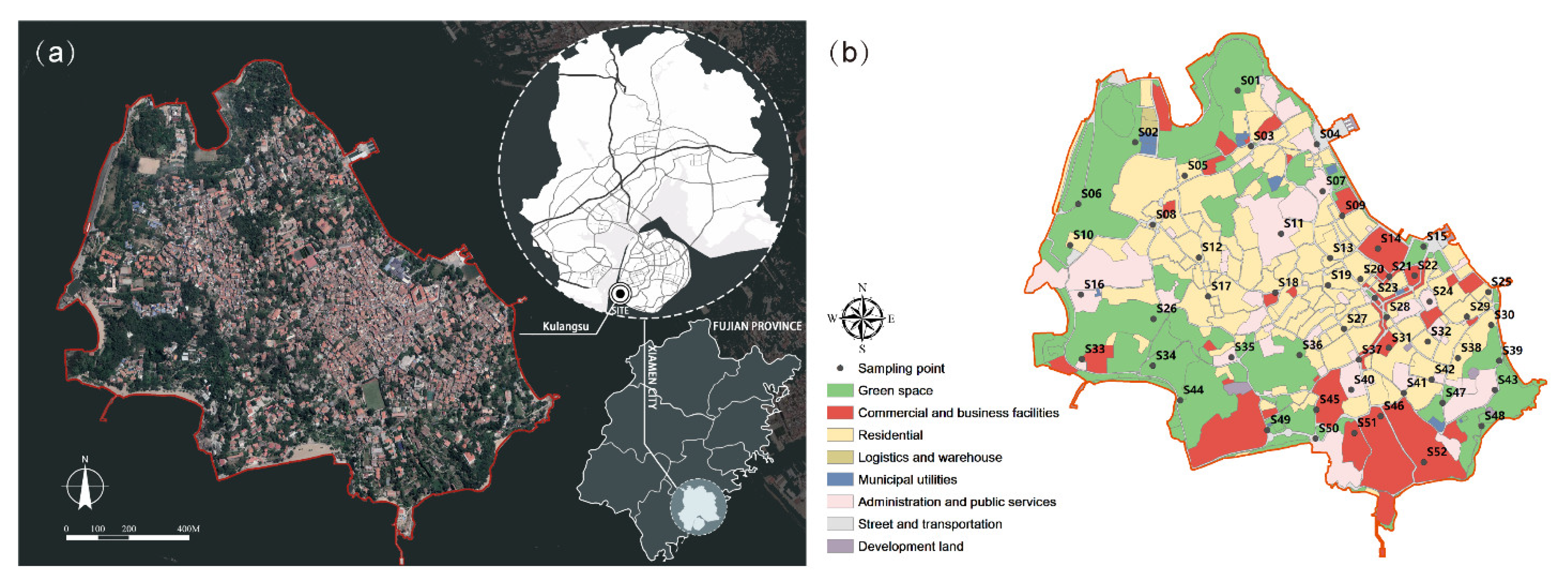
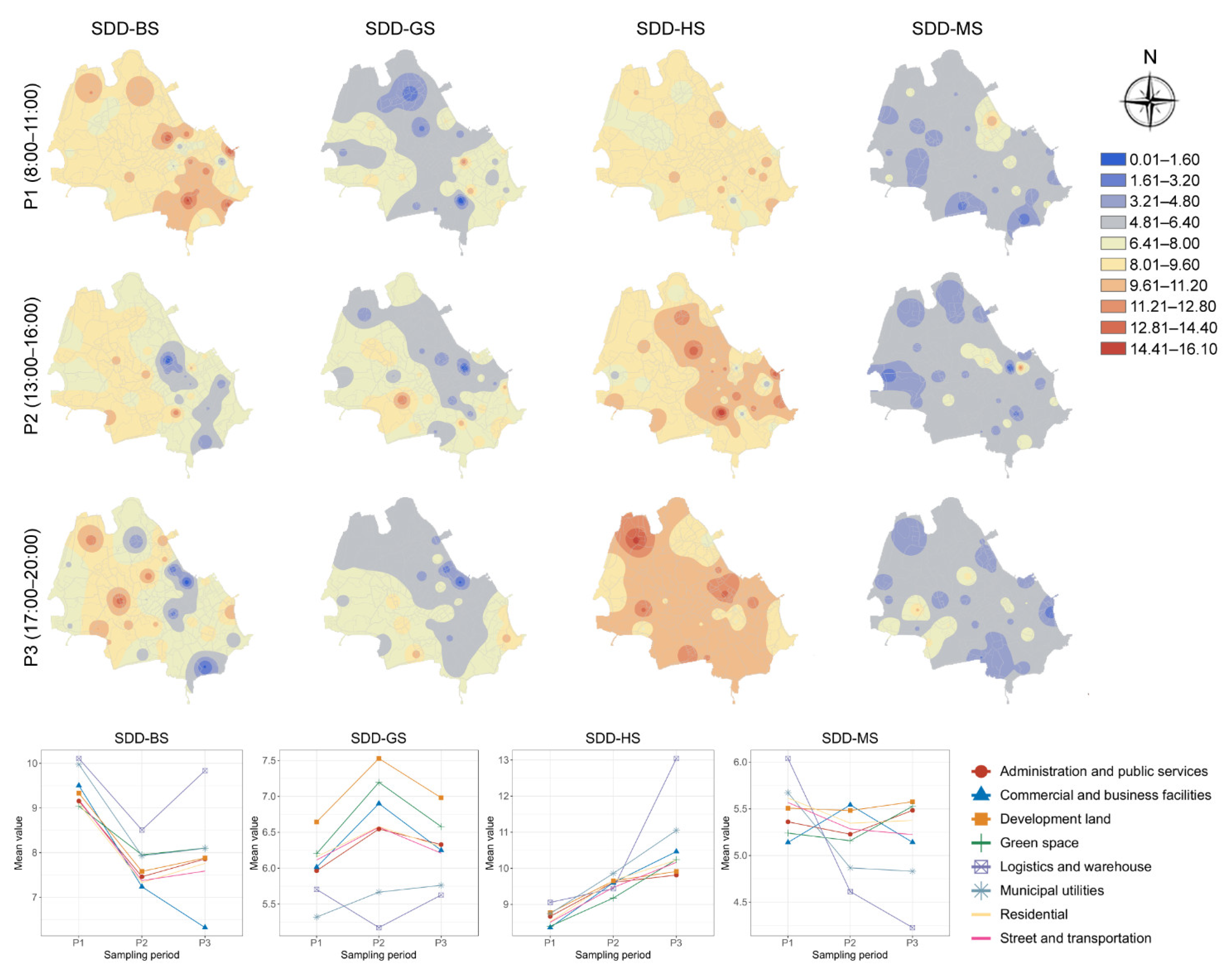
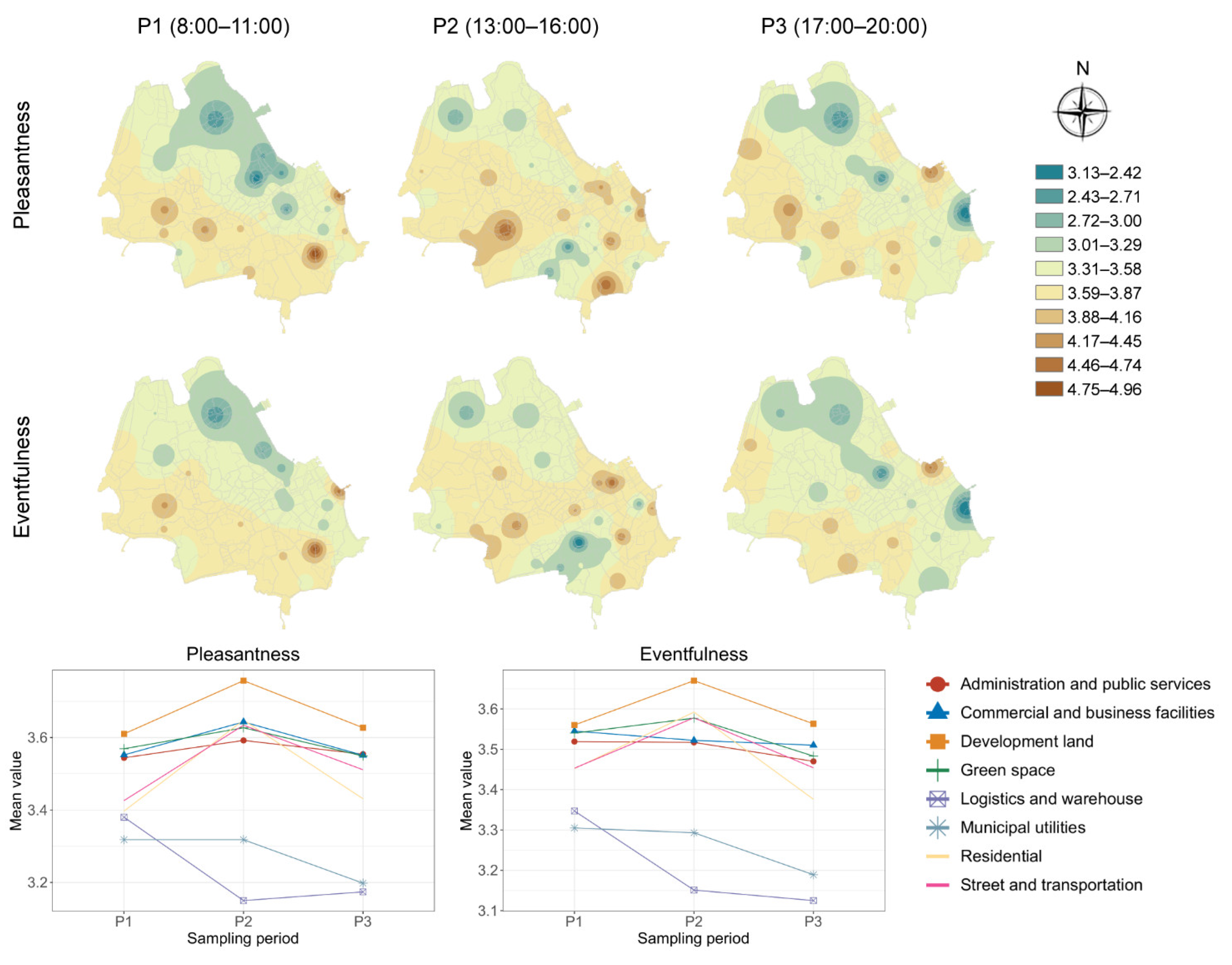
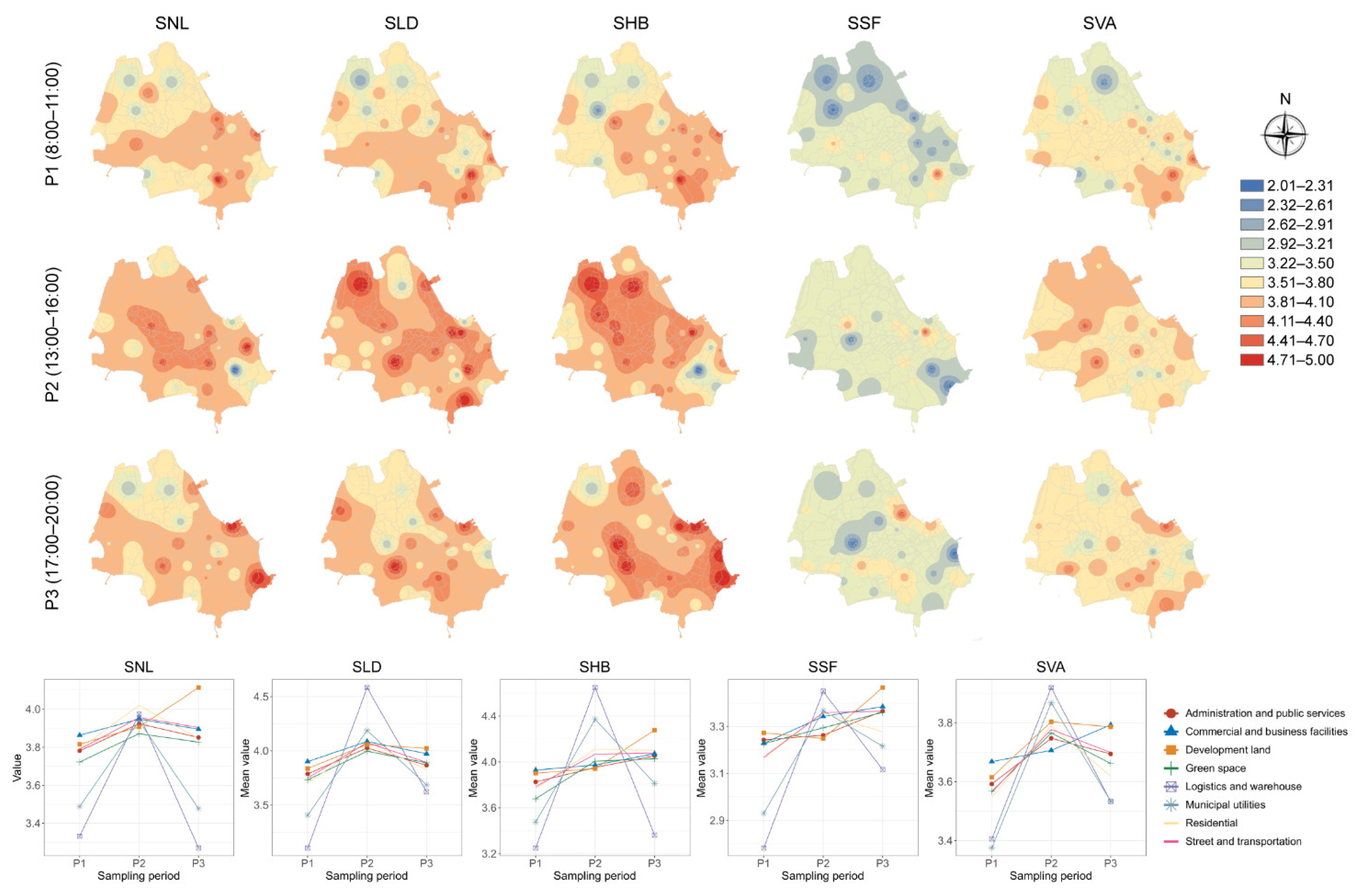
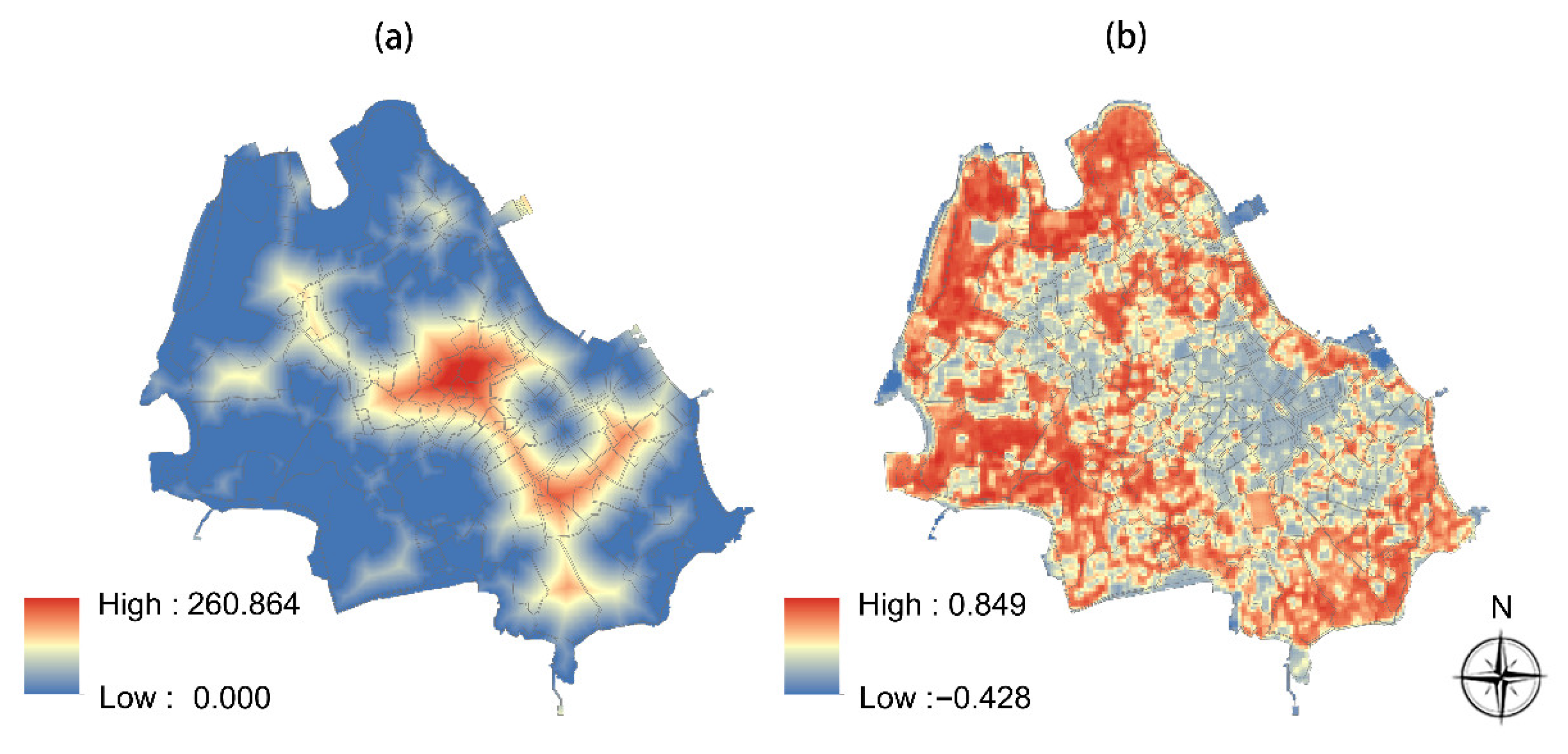

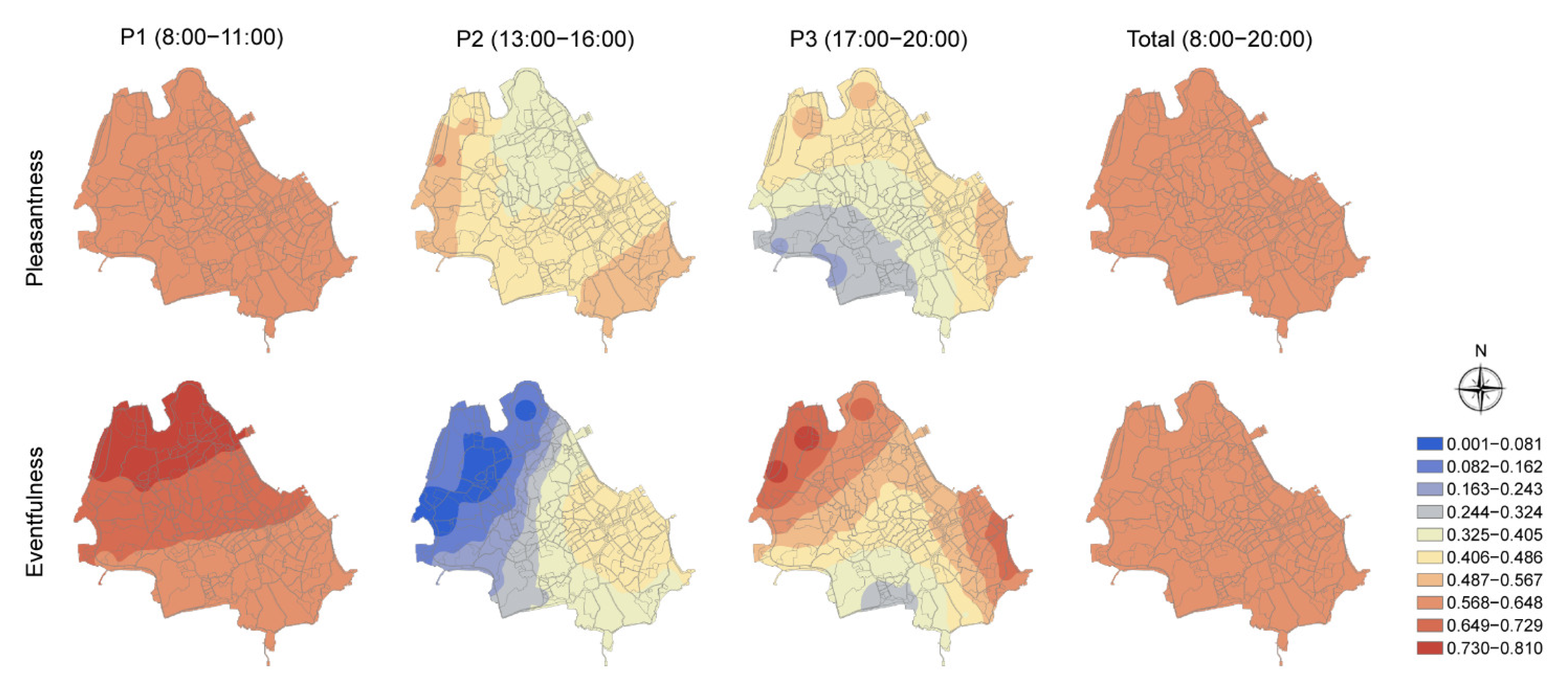
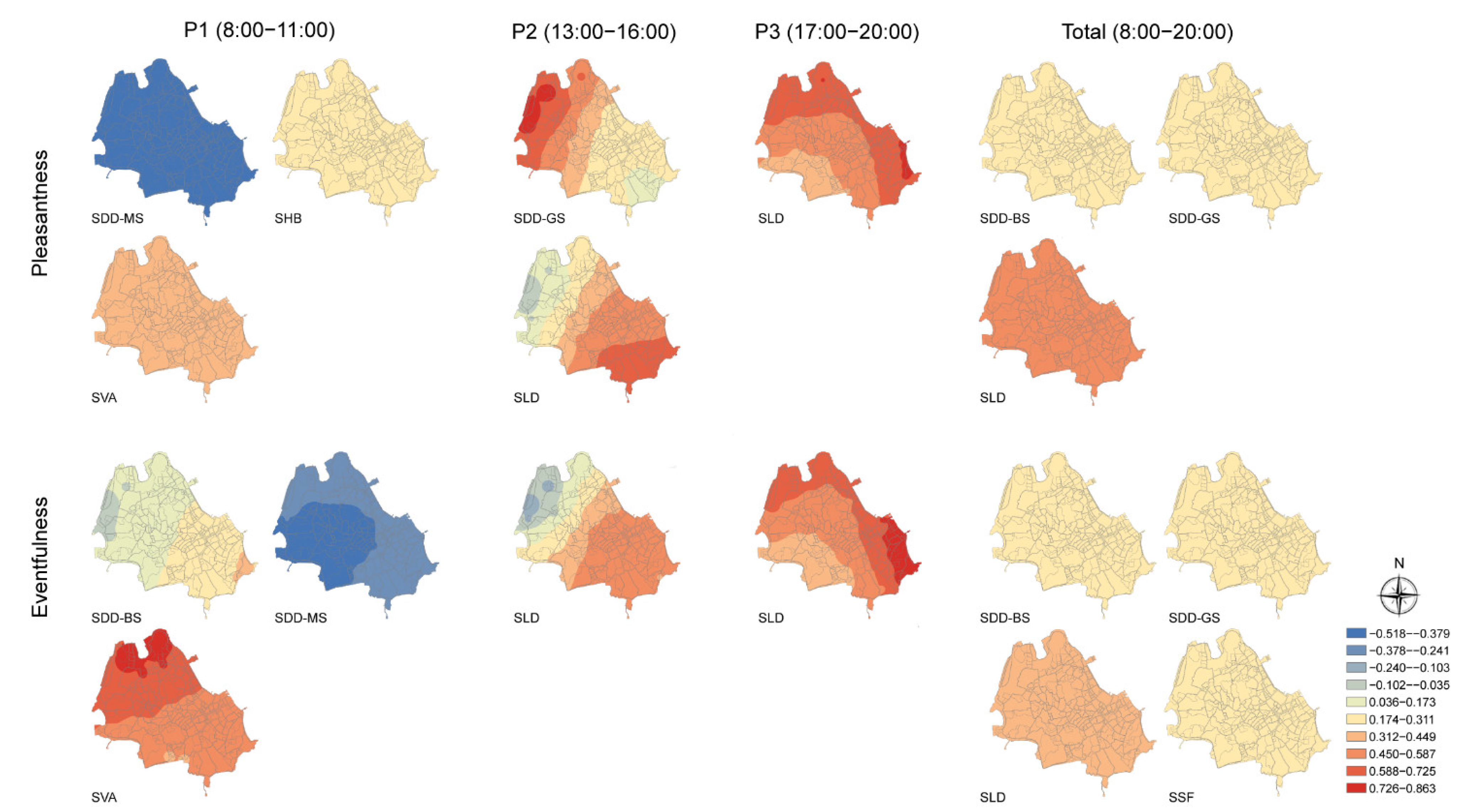
| Main Category (Abbreviation) | Sub-Category |
|---|---|
| Human activity sound (HS) | Talking, footstep, playing children, hawking, folk activity, live performance |
| Mechanical sound (MS) | Music radio, broadcast notification, construction, traffic noise, alarm |
| Biological sound (BS) | Birdsong, insect, cat |
| Geophysical sound (GS) | Sea wave, wind, tree, water, raining |
| Category | Indicators (Abbreviation) | Survey Question | Rating Scale or Formula | Reference |
|---|---|---|---|---|
| Sound source | Perceived occurrences of sound (POS) | To what frequency do you presently hear the following four types of sounds? | 1-never, 2-occasionally, 3-normal, 4-frequently, 5-too frequently | [12,17,24] |
| Perceived loudness of sound (PLS) | To what intensity do you presently hear the following four types of sounds? | 1-too weak, 2-weak, 3-neither weak nor strong, 4-strong, 5-too strong | ||
| Sound dominant degree (SDD) | / | SDDij = POSij × PLSij | ||
| Soundscape quality | Pleasant | To what extent do you agree or disagree that the present surrounding sound environment is …? | 1-strongly disagree, 2-disagree, 3-general, 4-agree, 5-strongly agree | [37] |
| Comfort | ||||
| Harmonious | ||||
| Vivid | ||||
| Richness | ||||
| Eventful | ||||
| Landscape satisfaction degree | Satisfaction of natural landscapes (SNL) | To what extent do you satisfy or dissatisfy that the present surrounding landscape with regard to …? | 1-very dissatisfied, 2-not satisfied, 3-general, 4-satisfied, 5-very satisfied | [12,27] |
| Satisfaction of landscape design (SLD) | ||||
| Satisfaction of historical building (SHB) | ||||
| Satisfaction of visual-audio experience (SVA) | ||||
| Satisfaction of service facilities (SSF) |
| Semantic Attribute | Component 1: Pleasantness (41.8%) | Component 2: Eventfulness (38.8%) |
|---|---|---|
| Pleasant | 0.880 | 0.250 |
| Comfort | 0.906 | 0.236 |
| Harmony | 0.739 | 0.441 |
| Vivid | 0.491 | 0.703 |
| Richness | 0.295 | 0.867 |
| Eventful | 0.195 | 0.877 |
| Sampling Period | Indicator | Pleasantness | Eventfulness | ||
|---|---|---|---|---|---|
| P1 | Independent variable | SDD-MS | −0.505 ** | SDD-BS | 0.170 * |
| SHB | 0.330 * | SDD-MS | −0.345 * | ||
| SVA | 0.312 ** | SVA | 0.407 ** | ||
| R2 | 0.653 | 0.591 | |||
| AIC | −59.061 | −56.234 | |||
| P2 | Independent variable | SDD-GS | 0.433 * | SLD | 0.295 ** |
| SLD | 0.362 ** | ||||
| R2 | 0.302 | 0.328 | |||
| AIC | −5.066 | −19.834 | |||
| P3 | Independent variable | SLD | 0.401 * | SLD | 0.497 ** |
| R2 | 0.379 | 0.418 | |||
| AIC | −17.154 | −31.585 | |||
| Total | Independent variable | SDD-BS | 0.196 ** | SDD-BS | 0.238 ** |
| SDD-GS | 0.299 ** | SDD-GS | 0.234 * | ||
| SLD | 0.510 ** | SLD | 0.504 ** | ||
| SSF | 0.351 * | ||||
| R2 | 0.649 | 0.591 | |||
| AIC | −62.988 | −50.111 | |||
| Sampling Period | Indicator | Pleasantness | Eventfulness | |
|---|---|---|---|---|
| P1 | R2 | Mean | 0.596 | 0.674 |
| Minimum | 0.588 | 0.577 | ||
| Maximum | 0.645 | 0.81 | ||
| AIC | −69.975 | −84.445 | ||
| P2 | R2 | Mean | 0.507 | 0.380 |
| Minimum | 0.343 | 0.001 | ||
| Maximum | 0.58 | 0.453 | ||
| AIC | −46.329 | −46.172 | ||
| P3 | R2 | Mean | 0.468 | 0.601 |
| Minimum | 0.212 | 0.258 | ||
| Maximum | 0.558 | 0.773 | ||
| AIC | −51.287 | −75.251 | ||
| Total | R2 | Mean | 0.598 | 0.615 |
| Minimum | 0.62156 | 0.64534 | ||
| Maximum | 0.62183 | 0.64564 | ||
| AIC | −84.948 | −80.86 |
Publisher’s Note: MDPI stays neutral with regard to jurisdictional claims in published maps and institutional affiliations. |
© 2022 by the authors. Licensee MDPI, Basel, Switzerland. This article is an open access article distributed under the terms and conditions of the Creative Commons Attribution (CC BY) license (https://creativecommons.org/licenses/by/4.0/).
Share and Cite
Chen, Z.; Zhu, T.-Y.; Liu, J.; Hong, X.-C. Before Becoming a World Heritage: Spatiotemporal Dynamics and Spatial Dependency of the Soundscapes in Kulangsu Scenic Area, China. Forests 2022, 13, 1526. https://doi.org/10.3390/f13091526
Chen Z, Zhu T-Y, Liu J, Hong X-C. Before Becoming a World Heritage: Spatiotemporal Dynamics and Spatial Dependency of the Soundscapes in Kulangsu Scenic Area, China. Forests. 2022; 13(9):1526. https://doi.org/10.3390/f13091526
Chicago/Turabian StyleChen, Zhu, Tian-Yuan Zhu, Jiang Liu, and Xin-Chen Hong. 2022. "Before Becoming a World Heritage: Spatiotemporal Dynamics and Spatial Dependency of the Soundscapes in Kulangsu Scenic Area, China" Forests 13, no. 9: 1526. https://doi.org/10.3390/f13091526







